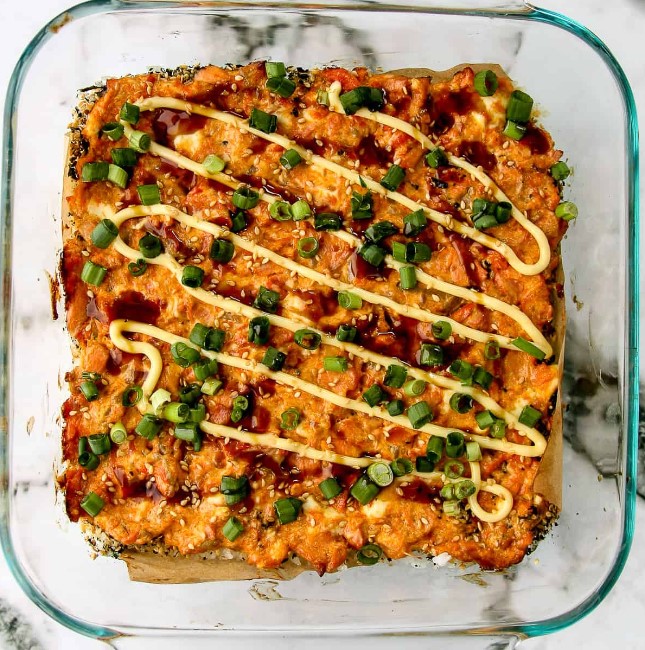Introduction to Salmon Sushi Bake
Introduction to the Dish
Salmon sushi bake is a culinary innovation that marries the intricate art of Japanese sushi with the comforting appeal of a Western-style casserole. This dish, a recent phenomenon in the food world, has rapidly gained popularity, especially on social media platforms where its unique presentation and delectable taste have captivated a global audience.
The history of salmon sushi bake is as layered as the dish itself. While its exact origins are somewhat nebulous, it is widely believed to have been popularized in the Philippines and Hawaiian potlucks. The dish is thought to be inspired by the viral TikTok salmon rice bowl by Emily Mariko, which showcases a similar deconstructed sushi concept.
Its cultural significance lies in its fusion nature, blending elements from different culinary traditions to create something both familiar and new. This dish is more than just a trend; it’s a testament to the evolving nature of global cuisine, where boundaries blur and flavors merge, resulting in creations that are not only delicious but also reflective of our interconnected world. The salmon sushi bake is not just a meal; it’s a celebration of culinary diversity and innovation.
What is Salmon Sushi Bake?
Salmon sushi bake is a creative and indulgent dish that reimagines the classic sushi experience. At its core, it’s a casserole that mimics the flavors and ingredients of traditional sushi but in a deconstructed, oven-baked form. This dish typically layers seasoned sushi rice, creamy mixtures of mayonnaise and cream cheese, flaked salmon, and a variety of toppings such as furikake, avocado, and cucumber. It’s finished with a drizzle of spicy mayo or eel sauce, adding depth and richness to the flavor profile.
Comparatively, traditional sushi is known for its meticulous preparation and presentation, featuring rice seasoned with vinegar, sugar, and salt, combined with various ingredients like seafood, vegetables, and sometimes tropical fruits. Sushi is often rolled in nori (seaweed) and presented in bite-sized pieces.
Salmon sushi bake, on the other hand, is more akin to a hearty, shareable casserole. It retains the essential flavors of sushi but presents them in a more casual, accessible format. This dish is perfect for gatherings where guests can scoop a portion onto their plates or seaweed sheets, enjoying the familiar sushi flavors in a novel and communal way.
Origins and Cultural Influence
The salmon sushi bake is a fascinating culinary creation that epitomizes the fusion of Japanese and Western culinary traditions. Its roots can be traced back to the innovative spirit of modern cooks who sought to blend the delicate, refined flavors of traditional Japanese sushi with the hearty, communal essence of a Western-style casserole. This dish represents a cultural amalgamation, where the precise art of sushi meets the comfort and convenience of a bake.
The concept of sushi, originating from Japan, is traditionally associated with meticulously crafted rolls or nigiri, showcasing the purity and flavor of raw fish, complemented by seasoned rice. The salmon sushi bake takes these fundamental elements but transforms them into a layered, oven-baked dish that is more in line with Western casserole practices. This approach makes the dish more approachable and easier to prepare, especially for those unfamiliar with the art of sushi rolling.
The origins of salmon sushi bake are somewhat debated. Some credit its creation to Mimi Qiu Reyes, founder of The Original Baked California Roll in the Philippines in 2015. Others believe it gained popularity at Hawaiian potlucks earlier. Regardless of its origins, this dish is a beautiful example of culinary creativity and fusion cuisine.
Recipe and Preparation
Key Ingredients
The allure of salmon sushi bake lies in its simplicity and the symphony of flavors created by its key ingredients. At its heart, this dish requires:
- Sushi Rice: The foundation of the dish is sushi rice, seasoned with a blend of rice vinegar, sugar, and salt, which gives it a distinct, slightly tangy flavor..
- Salmon: Typically, use boneless, skinless salmon, either fresh or canned. Lightly season and cook it before flaking it into the bake.
- Mayonnaise and Cream Cheese: Mix mayonnaise and cream cheese with the salmon to create a creamy, rich texture. Prefer Japanese mayonnaise, like Kewpie, for its slightly sweeter and umami profile.
- Sriracha: For a spicy kick, mix sriracha sauce into the dish, lending a garlicky heat. You can find a simple eel sauce recipe on FeedMi.
- Furikake: Sprinkle furikake, a Japanese seasoning made from dried fish, sesame seeds, chopped seaweed, sugar, and salt, over the top for an umami crunch.
- Additional Toppings: Green onions, avocado, cucumber, and seaweed sheets are common garnishes that add freshness and texture.
Step-by-Step Cooking Guide
Creating a salmon sushi bake is an enjoyable and straightforward process. Here’s a detailed guide to help you craft this delightful dish:
- Prepare the Sushi Rice:
- Cook the sushi rice as per package instructions.
- Once cooked, season it with a mixture of rice vinegar, sugar, and salt. Stir gently and let it cool to room temperature.
- Cook the Salmon:
- Preheat your oven to 375°F (190°C).
- Season the salmon fillets with salt, pepper, and a touch of garlic powder. Place them on a baking sheet lined with parchment paper.
- Bake the salmon for about 15-20 minutes, or until it is fully cooked and flakes easily with a fork.
- Once cooled, flake the salmon into small pieces.
- Make the Creamy Salmon Mixture:
- In a bowl, combine the flaked salmon, mayonnaise, cream cheese, and sriracha. Mix until well combined. Adjust the sriracha according to your spice preference.
- Assemble the Bake:
- In a baking dish, spread the cooked sushi rice evenly at the bottom.
- Sprinkle a generous layer of furikake over the rice.
- Spread the creamy salmon mixture over the furikake layer.
- Bake the Dish:
- Preheat the oven to 400°F (205°C).
- Bake the assembled dish for about 10-15 minutes, or until the top starts to turn golden brown.
- Add Final Toppings:
- Garnish the baked dish with additional furikake, sliced green onions, diced avocado, and cucumber.
- Serve:
- Serve the salmon sushi bake warm with sheets of nori (seaweed) or with a side of soy sauce for dipping.
Tips for Perfecting the Dish
- Rice Consistency: Ensure the sushi rice is slightly sticky for the perfect texture.
- Salmon Quality: Use fresh or high-quality canned salmon for the best flavor.
- Balancing Flavors: Adjust the amount of sugar, salt, and vinegar in the rice to suit your taste.
- Creamy Mixture: Blend the mayo, cream cheese, and sriracha thoroughly for a smooth, even layer.
- Baking Time: Keep an eye on the bake during the final minutes to prevent over-browning.
- Serving Suggestion: For a traditional sushi experience, serve with pickled ginger and wasabi on the side.
This salmon sushi bake is not just a dish; it’s a delightful culinary journey that brings together diverse flavors and textures, promising a memorable dining experience.
Visit these articles for more recipes:
Serving and Presentation
The salmon sushi bake offers a versatile canvas for creative serving and presentation. Traditionally served in the baking dish, it invites guests to scoop their desired amount onto their plates or directly onto nori sheets, creating their own sushi-like wraps. This interactive serving method adds a fun, communal aspect to dining.
For a more elegant presentation, portion the bake into individual servings, layering them neatly on small plates or bowls. Garnish each serving with a sprig of green onion or a slice of avocado for a touch of color and freshness.
Pairing this dish with sides and drinks can elevate the entire meal. Consider these options:
- Sides: Serve with a light cucumber salad or edamame beans for a refreshing contrast. You can offer pickled ginger and wasabi on the side for an authentic sushi experience
- Drinks: Pair with a crisp, dry white wine like Sauvignon Blanc or a light Japanese beer to complement the flavors. For a non-alcoholic option, green tea or a light, citrus-infused sparkling water pairs beautifully.
The key to serving salmon sushi bake is to balance the richness of the dish with light, refreshing sides and drinks, creating a harmonious and enjoyable meal experience.
Customization and Variations
Dietary Adaptations for salmon sushi bake
FAQs
- Can I use different types of rice?
- Yes, but sushi rice gives the best results.
- Is it possible to make it less spicy?
- Absolutely, adjust the sriracha to your preference.
- Can I prepare this dish ahead of time?
- Yes, you can assemble it ahead and bake it just before serving.
Conclusion and Additional Resources
In conclusion, salmon sushi bake is a versatile, delicious, and easy-to-make dish that brings a unique twist to traditional sushi. It’s perfect for potlucks, family dinners, or when you crave sushi flavors without the hassle of rolling.
For more information on perfecting your sushi bake, check out this guide on making perfect basmati rice and explore different variations of sushi bake, including the addition of Thai sweet chili sauce for a spicy twist.


